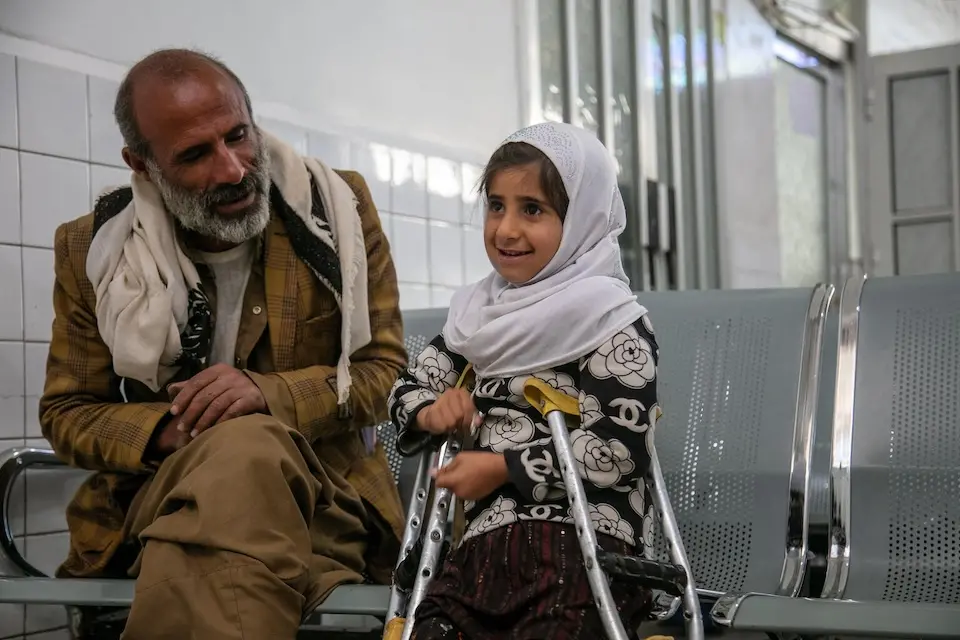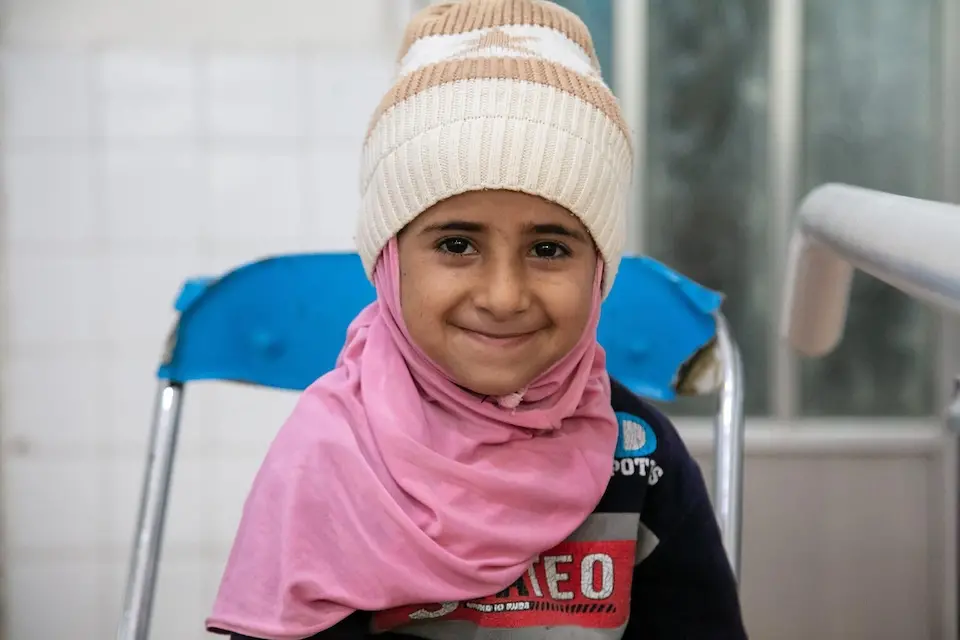Inclusion is not just an aspiration; it's a human right. UNICEF works with partners to ensure children with disabilities get the support they need to participate fully in the world and reach their full potential.
Nearly 240 million children worldwide — 1 in 10 — are living with disabilities. In Yemen, that figure is even higher. An estimated 18 percent of Yemen’s child population have functional difficulty in at least one domain, including seeing, hearing, walking, fine motor, communication, learning, playing and managing emotions.
Disability becomes even more challenging when combined with poverty, conflict, family neglect and limited access to medical care. Children often bear the heaviest burden, paying the price of war with their health and, in some cases, their limbs.
 After two years of battling a stubborn infection that started in her heel, 9-year-old Khadija's right leg was amputated below the knee. ©UNICEF/UNI719207/Qadari
After two years of battling a stubborn infection that started in her heel, 9-year-old Khadija's right leg was amputated below the knee. ©UNICEF/UNI719207/Qadari
To ensure children who lose their limbs are not kept on the sidelines by their families' inability to afford prosthetics, UNICEF has partnered with the Prosthetics and Rehabilitation Center (PRC) in Sana’a Governorate to help children get the life-changing services they need.
Since 2021, the PRC, with UNICEF's support, has provided vital assistance to 109 children (33 girls and 76 boys) across Yemen. In October 2024, UNICEF supplied prosthetics materials for an additional 500 children, helping the center further its mission of restoring hope.
 Khadija, 9, and her father, Shayef Aishan, sit together telling jokes as they await the fitting of her prosthetic limb at the Prosthetic Center in Sana’a Governorate, Yemen. © UNICEF/UNI719304/Qadari
Khadija, 9, and her father, Shayef Aishan, sit together telling jokes as they await the fitting of her prosthetic limb at the Prosthetic Center in Sana’a Governorate, Yemen. © UNICEF/UNI719304/Qadari
A new leg brings fresh hope
Shayef Aishan, a 55-year-old farmer from Jabal Yazeed, Amran Governorate in west central Yemen, shares the story of his 9-year-old daughter, Khadija.
"A wound started to appear on her heel. We treated it for two years. She underwent several surgeries and we sought care in various hospitals, but nothing helped. Eventually, doctors said amputation was the only solution," he recalls.
After Khadija's foot and lower leg were amputated, Shayef heard from another patient’s guardian about the support UNICEF provides through the PRC in Sana’a. He made an appointment for Khadija to visit the center. Before long, she Khadija received a prosthetic leg made just for her.
 Khadija's prosthetic leg was carefully crafted to ensure a perfect fit. © UNICEF/UNI719239/Qadari
Khadija's prosthetic leg was carefully crafted to ensure a perfect fit. © UNICEF/UNI719239/Qadari
Her prosthetic limb helped 9-year-old Khadija get back to learning
"Khadija didn’t sleep all night; she was so happy with her new foot," Shayef says with joy. "She couldn’t wait to return home and start walking again. I thank UNICEF for filling our hearts with joy that we never thought we’d feel again."
Khadija had to drop out of school during the years she was battling the infection. Once she had her prosthetic leg, returning to the classroom became her top priority. She has the full support of her father, who treasures her as the only girl among his seven children.
 Dr. Afrah Al-Harassi, a prosthetic technician, trains Khadija on walking with her new prosthetic limb, guiding her with patience and expertise as she takes each step toward regaining her independence. © UNICEF/UNI719318/Qadari
Dr. Afrah Al-Harassi, a prosthetic technician, trains Khadija on walking with her new prosthetic limb, guiding her with patience and expertise as she takes each step toward regaining her independence. © UNICEF/UNI719318/Qadari
Learning to walk again
Dr. Afrah Al-Harassi, a prosthetic technician at the PRC in Sana’a, was instrumental in helping Khadija regain her mobility.
"Khadija had a strong will and passion to continue her education," Al-Harassi recalls. "She even arrived in her school uniform, determined to return to her studies immediately."
Fitting a prosthetic limb requires physical and psychological preparation. "We focus on training patients to strengthen their muscles, balance their weight on the amputated part, and monitor for any issues like redness caused by pressure," says Al-Harassi. "But just as important is helping them accept the new limb and realize they can overcome any difficulties."
Khadija’s resilience allowed her to adapt quickly, in stark contrast to others who often take months to adjust to a prosthetic. "Her ambition to continue her education made her response to the new situation faster and smoother," Al-Harassi says.
 Khadija on her own two feet at the Prosthetic Center in Sana’a Governorate, Yemen. © UNICEF/UNI719306/Qadari
Khadija on her own two feet at the Prosthetic Center in Sana’a Governorate, Yemen. © UNICEF/UNI719306/Qadari
Transforming lives through partnership
UNICEF’s support has been vital to the PRC's operations, allowing many children like Khadija to regain their independence. "I thank UNICEF and hope they will continue amplifying their support," Al-Harassi says. "There are so many children who need these services but cannot afford them due to Yemen's dire economic situation."
By restoring mobility and hope, UNICEF and its partners continue to transform the lives of Yemen's children, ensuring they can overcome challenges and build a brighter future.
 Nine-year-old Khadija is thrilled to be walking again with her new prosthetic leg and support from UNICEF. © UNICEF/UNI719233/Qadari
Nine-year-old Khadija is thrilled to be walking again with her new prosthetic leg and support from UNICEF. © UNICEF/UNI719233/Qadari
Right now, the lives of the most vulnerable children hang in the balance as conflicts and crises jeopardize the care and protection that they deserve. Dependable, uninterrupted and effective foreign aid is critical to the well-being of millions of children.










-1.png)


